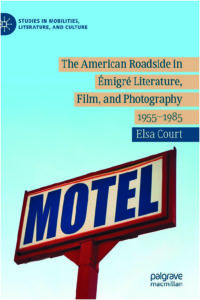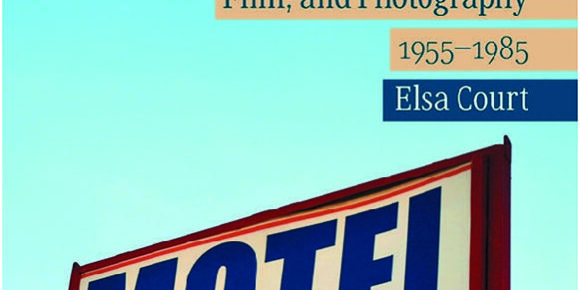The American Roadside in Émigré Literature, Film, and Photography 1955-1985
By Elsa Court
Cham, Switzerland: Palgrave Macmillan, 2020
193 pp., hardcover, $84.99
Reviewed by Paul Sherman
 Ever since Alexis de Tocqueville roamed the fledgling United States and wrote Democracy in America, the idea that the fresh eyes and ears of a foreign intellectual can provide insights that natives might miss has become something of a trope.
Ever since Alexis de Tocqueville roamed the fledgling United States and wrote Democracy in America, the idea that the fresh eyes and ears of a foreign intellectual can provide insights that natives might miss has become something of a trope.
Elsa Court’s The American Roadside in Émigré Literature, Film, and Photography 1955-1985 hopes to tap into that outsider perspective on two levels. Its author is a French native who is currently an academic in England, while her book’s case-study structure focuses on four celebrated works by émigrés featuring the American roadside: Russian Vladmir Nabokov’s novel, Lolita (1955); Swiss Robert Frank’s photography collection, The Americans (1958); English Alfred Hitchcock’s thriller, Psycho (1960); and German director Wim Wenders’ southwestern drama, Paris, Texas (1984).
The trope’s results are only mixed this time. Court’s uneven analytical framework for her subjects, as well as her occasional misreadings, make The American Roadside a missed opportunity.
One thing about Court’s book should be noted up front. She is working in the social science of mobilities, which looks at the movement of people and objects, and the resultant travel of ideas. Her concerns are usually more theoretical than the social, economic and cultural contexts of the built environment on which this organization tends to focus. Although her book sometimes refers to the work of John Jakle, familiar to many SCA members, she more often attempts to build upon the writings of European spatial theorists, including Marc Augé and Jean Baudrillard, with whom I am unfamiliar.
That said, I still wish the book had more to offer to anyone who rates all four of Court’s subjects as significant and doesn’t mind a little academic writing. At its best, a case-study structure like the one Court uses will emerge as a set of united observations that is greater than the sum of its parts. In this case, though, the sections in The American Roadside seem overly compartmentalized. There is no “build” to this book as it progresses.
You might expect some fertile interplay between the section on the motel-heavy Lolita and that on the largely motel-set Psycho, but instead of talking to each other, these chapters almost contradict each other. In her writing on Lolita, in which European intellectual Humbert Humbert takes pre-teen stepdaughter/lover/hostage Dolly (a/k/a Lolita) on an extended road trip, Court focuses on the American motel as a site of transience and, potentially (certainly in the case of Lolita) transgression. Yet, when turning to Psycho, Court does not manage to link the murders at the Bates Motel to the propensity for motels to shelter transgression that she has already established. Instead of building on that notion, she instead focuses on the decadent Bates Motel being bypassed by the construction of a new highway and on a questionable analysis of the spatial relationship between the squat motel and the gothic Bates family home overlooking it (more on this later).
The focus of Court’s research also seems questionable in her chapter on Frank’s The Americans. In its 1959 American edition, Frank’s photo book has an introduction by Jack Kerouac, and Court dwells on Kerouac’s embrace of Frank’s work and methods, in both that introduction and a later article the On the Road author penned on a road trip he took with Frank.
The implication seems to be that outsider Frank’s work has been accepted by American insider Kerouac, but Court fails to realize that the these two men had similar relationships to the American roadside—Kerouac was a native of a dissipated New England mill town whose youth was heavily steeped in French Canadian culture, and the western roadside was nearly as “foreign” to him as it was to Frank. Court even includes a quote from photographer Stephen Shore sharing this view of Frank and Kerouac as more similar than different late in her chapter, and her counterargument that Kerouac’s fame had changed his status does not convince. (Court’s distinction between On the Road and Lolita makes more sense, as Nabokov’s roadside is filtered through the character of Humbert Humbert, whose unfamiliarity with America is one of the features that make him an unreliable narrator.)
Despite the spectre of Kerouac hovering over both the Lolita and The Americans chapters, there are few crossovers among chapters to strengthen Court’s observations and conclusions. Similarly, she has no consistent approach to address the inconsistent émigré status of her four “authors”—Hitchcock and Frank had been working in the U.S. for many years, Nobokov and Wenders were newer to these shores. The Psycho chapter barely even makes an attempt to convey whatever émigré perspective Hitchcock might have had after two decades of making movies in Hollywood. Other tangents in the book stray too far from the émigré issue, as well, particularly one about Susan Sontag’s railings against “trivial” photographic subjects in The Americans chapter.
But, back to the misreadings of Psycho and other aspects of the works at hand. I had trouble with her depiction of the roadside Bates Motel as “a site of unhealthy obsessions” in comparison to the (literally and figuratively) higher Bates house. Isn’t any distinction just the swerve in Hitchcock’s storytelling? As a thriller, of course, all is not as it initially appears in Psycho, and that includes the relative roles of the house and the motel. The idea that the house is a safe place in relation to the motel is revealed to be a fallacy by the movie’s second half and certainly by the time of the last act’s lengthy psychiatric explanation of the extent and locations of Norman Bates’ crimes.
A misreading is even more blatant in the Paris, Texas chapter. In addition to misidentifying Paris, Texas as Wenders’ first movie shot entirely in America (that would be 1982’s Hammett), Court devotes significant space and a photo to a set of train tracks on which the characters played by Harry Dean Stanton and Dean Stockwell walk. She unfortunately characterizes these tracks as abandoned and makes much of their unattended overgrowth and symbolism, when, not a minute before in the movie’s action, we see a train travel on these same tracks. Court also mistakes a desolate state for near-abandonment in Robert Frank’s personless shot of a gas station on a bleak road in Santa Fe. The notion of a more remote, less-peopled southwest, 60 or even 35 years ago, seems to elude Court.
In other unfortunate inclusions, Court’s description of the Cabazon, California, steel-and-concrete dinosaurs, the backdrop for a Paris, Texas sequence, as examples of Googie architecture is simply wrong, as is her use of the word “irregardless” at one point.
Court’s book also raises the question of how exactly one defines the roadside. She distinguishes between the road and the roadside—something that, frankly, has never occurred to me—and shows no interest in Frank’s vivid shots of an actual western road stretching to the horizon, the bustle inside an urban Miami hotel elevator and a segregated New Orleans trolley. She is consistent in her focus, but this interpretation seems limiting. For instance, she never even mentions the rooms-by-the-hour downtown Phoenix hotel that kicks off Psycho with adultery and the seeds of a robbery. Talk about transience and transgression.
Paul Sherman is the author of Big Screen Boston: From Mystery Street to The Departed and Beyond. He has been an SCA member since 2002.
This book review originally appeared in the SCA Journal, Spring 2021, Vol. 39, No. 1. The SCA Journal is a semi-annual publication and a member benefit of the Society for Commercial Archeology.
More Book Reviews


